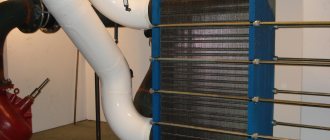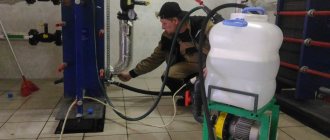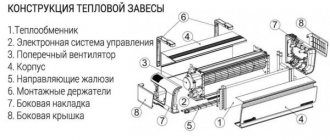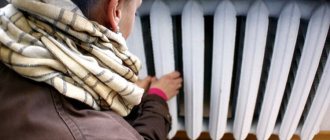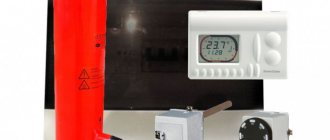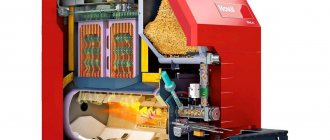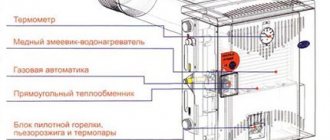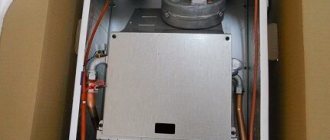Advantages and disadvantages
Systems operating on the principle of air heating have a number of advantages over analogues.
- Fast heating of the room. The pressure of hot air warms up the space much faster than the warm waves emanating from a radiator with water.
- Even heat distribution. Air outlet points, as well as built-in adjustable dampers, allow you to warm up different levels of the room, while the heat from convection heaters rises clearly upward. As a result, the air near the ceiling can be sufficiently warmed up, while the floors and lower part of the space remain cool.
- Economical. The operation of air heating units is less expensive than heating with water radiators or air conditioners.
The disadvantages of heating units of a centralized system include several points.
- The complexity of laying air pipes, the need to create and approve a diagram.
- Special safety requirements for the installation of electric and gas boilers.
- External units do not always have an aesthetic appearance, since most often they are designed for use in industrial premises. However, the modern market already offers models with multi-colored plastic cases that can be matched to any room design.
With proper design and installation, taking into account all the individual nuances of the living space, air heaters will become an excellent functional heating system for the home. According to reviews from Russian and foreign users, the most popular option is an air-heating unit with a water heat exchanger and a central boiler unit.
Types of air heating units
Heaters are divided into varieties according to 2 criteria: air flow and the type of heating element - heat exchanger. If relatively low flow rates of heated air are required, which does not need to be moved throughout the building, then an axial fan is traditionally used. More powerful air heating systems, serving several rooms or entire buildings, are driven by centrifugal fans, an example of which is shown in the figure:
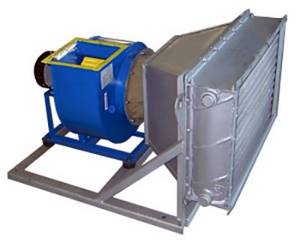
Note. On the free side, an air duct is attached to the heat exchanger flange, distributing heat within one room or an entire structure.
To heat the air flow, the following types of heat exchangers are installed in the units:
- electrical;
- water;
- steam.
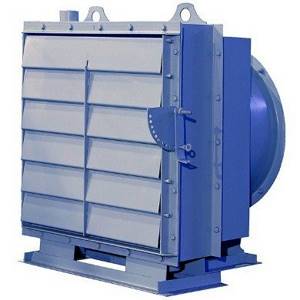
The scope of application of electric heaters is quite limited, there are a number of reasons for this. The first is the lack of electrical power on the line. As you know, to produce 1 kW of heat, about 1 kW of electricity is required, which means that for a hall with an area of 500 m2, a power of 50 kW is needed. Not every network is designed to supply this amount of energy.
Another difficulty lies in heating control, because operating at maximum is not always necessary, and high-power electric air-heating units cannot be adjusted smoothly. This will require too expensive electrical equipment, so two or three-stage heating is usually implemented. Therefore, most often such devices are used in small and medium-sized rooms, because their maximum power rarely exceeds 30 kW. As an example, here are the technical characteristics of Polish electric heaters JUWENT AGE:

10.2. Air heating system diagrams
Figure 10.1 shows schematic diagrams of local air heating systems. Pure heating systems with complete recirculation of the air coolant can be ductless (Fig. 10.1, a) and ducted (Fig. 10.1, b). With a ductless system, internal air having a temperature tb is heated by the primary coolant in the air heater to a temperature tg and is moved by a fan into the heated room. The presence of a vertical channel for hot air causes the emergence of natural pressure, which ensures the circulation of internal air through the heater and its supply to the room. These two schemes are used for local air heating of rooms that do not require artificial supply ventilation.
| A) | b) | ||
| 1 | tG | 3 | tG |
| 2 | 4 | 2 | |
| tB | tB | ||
| V) | 7 | G) | 7 |
| 5 | 5 | ||
| tG | tУ | tУ | |
| tH | tH | tG | |
| 6 | t | 2 | 2 |
| IN | tB |
Rice. 10.1. Schematic diagrams of local air heating systems: a, b – completely recirculating; c – partially recirculating; g – direct flow; 1 – heating unit; 2 – working (serviced) area; 3 – channel with heated air; 4 – heat exchanger (heater); 5 — external air intake; 6 – recirculated air; 7 – exhaust ventilation
Air heating units with an electric heat source
Home / Product catalog / Air heating units
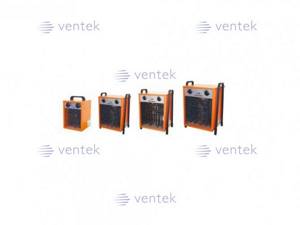
| Ask a Question | Request for equipment |
General information
Heating units with an electric heat source are designed for recirculating air heating of premises as main or auxiliary heating sources.
Design
Heating units or heat guns have a body made of sheet steel with a polymer coating. Thermal resistance of the external and internal polymer coating is 180 ºС.
Inside the case there is an electric heater (TEH), made of stainless steel and a fan, through which flows of cold and then heated air move inside the room.
Electrically heated heat guns typically use axial fans with an external rotor motor, protection class IP 54.
The fan impellers (impellers) are made of aluminum or steel with a high-quality polymer coating, which allows the fan elements to be protected from high temperatures for a long time.
In addition, the fan is equipped with an emergency shutdown device for heating elements in the event of an increase in the housing temperature above the permissible level.
terms of Use
- Ambient temperature from minus 40 to plus 40ºС;
- Relative air humidity at a temperature of 20ºС is more than 80%;
- Retention of dust and other impurities in the air no more than 10 mg/m3;
- The presence in the air of sticky and fibrous materials, flammable substances, resins, as well as substances aggressive towards carbon steels of ordinary quality (acids, alkalis) is not allowed.
Technical characteristics of heat guns with electric heating
Heating units CE series
Heating units TE series
Electric air heaters LEO EL
Specifications LEO EL
Accessories LEO EL
Automation and connection diagrams LEO EL
How to order an air heating unit from our company?
In order to find out the cost of an air heating unit from the VENTEC Company, you can:
- call our specialists by phone +7 (8452) 746-512
- send technical requirements for the air heating system or a completed questionnaire by email
- click “Order a call”, and our specialist will contact you at the contacts you provided
Our specialists not only supply equipment for ventilation of your facility, but also design industrial ventilation systems, its installation and commissioning.
| Ask a Question | Request for equipment |
Basic elements of the heating system
Before making air heating at home with your own hands, you need to review all the elements, components and significant details of the structure.
Devices for heating air flows
The equipment is designed to heat flows to the required temperature. Heat sources are used that heat the masses by passing them through a heat exchanger with heated steam, or heat the flows inside the heating element.
There are 4 types of heat generators used for air heating systems:
- Direct heating fuel systems, where the flows are heated due to the combustion of any fuel. This can be coal, diesel fuel, firewood; this type includes air-fired gas heating - when burned, the gas warms up the air, which is transported through air ducts throughout the premises.
- Electric units with direct heating are powerful fan heaters mounted to air ducts.
- Indirect heating units. The system involves installing a heat exchanger where hot liquid constantly circulates. The liquid is heated by any known method, and as an option, you can consider connecting the coolant from the central water supply system.
- Combined system. This is a universal option that combines several types of air heating, for example, liquid and electric options. The combined system is suitable for installation in private homes. In this case, the rooms will be heated even when the power supply is turned off.
Channels for transporting air masses
Air ducts are a mandatory element of the system. Through them, the coolant enters the room and returns back for heating. Most often, a circular transportation circuit is installed, which has more functionality than single-pipe circuits.
A circular structure is made of two main pipelines made of galvanized metal. One line is supply, the second is return. Air ducts of a smaller cross-section are connected to the pipes, which are laid in the rooms. Flexible air ducts must be sealed and insulated. Aluminum tape is used for sealing, and foil heat insulators 25-30 mm thick are used for insulation. The mains also need to be insulated with foil insulation 3-10 mm thick.
Fans
Duct fans are needed for forced transportation of a flow of heated air. Installation on the supply and return lines is selected taking into account the possibility of adjustment, operation at different speeds, resistance to voltage surges, and smooth start-up. The technical parameters of the units must exactly match the specific heating system in order to maintain the pressure performance of all equipment.
Grilles and diffusers for flow distribution
All air ducts located in the room are connected to these elements. Grilles and diffusers are needed to provide air conditioning and heating systems by uniformly mixing air flows. Wall-mounted and floor-mounted models with adjustable and non-adjustable blinds are available for sale.
In-channel dampers and valves
Details are important to ensure the throughput of the entire structure. Throttle dampers are fixed in the supply lines to regulate air flows to different rooms. Valves are needed for different sections of air ducts, for example, a supply element is required to regulate the flow of air from the street.
Air preparation equipment
When setting up homemade air heating combined with air conditioning, the system must be equipped with filters. These can be carbon, mechanical or electrostatic devices that clean air flows from impurities. The scheme is also complemented by ionizers, humidifiers and other types of units.
Automatic control systems
To simplify the coordination of the entire circuit, it is recommended to select a control unit. The choice is made according to the type of heating functionality, allows you to control the operation of devices, change the program of actions, distribute air flows across zones depending on the needs of the user.
The main advantages of air heating units of the Vulcan brand
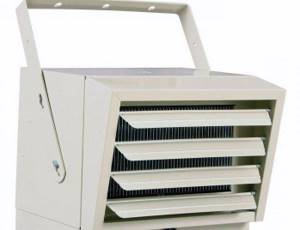
If you need a heating unit, then you can consider one of the models described above as an option. The main advantages of these devices are:
- high efficiency of the fan heater;
- low operating costs;
- optimal air jet range;
- reduced noise level;
- high thermal power;
- full regulation of technical parameters;
- simple and quick installation and assembly.
With the help of this equipment you will be able to heat and then automatically maintain the desired level of air temperature in a room or building. In this case, the coolant will heat up to 90 °C. The Vulcan heating unit does not use air masses from the outside in its operation, since it is designed to recirculate the air that is inside the building.
As an additional feature, we can highlight the fact that the units have the ability to redistribute air masses; this is ensured by built-in axial fans and guide grilles in the form of blinds. With the help of the latter, flows can be directed to almost any part of the structure or room.
Air heating unit STD-300
| The STD-300 unit is a single-jet air-heating unit designed to work with a coolant - hot water (for STD-300V based on a KSk heater) or dry steam (for STD-300P based on a KP-Sk steam heater) with a working pressure of not more than 1.2 MPa and a temperature of no more than 190°C. The air-heating unit STD-300 is used for heating air in industrial and agricultural premises, in heating and ventilation systems in temperate climates, the maximum permissible content of chemically aggressive substances in the air according to GOST 12.1.005-88, with a dust content of no more than 0, 5 mg/m3 and does not contain sticky substances or fibrous materials. Heating units STD-300 (water) are manufactured in the right-hand version, the heater pipes are on the right when viewed from the side of the axial fan, and the left-hand version - the pipes are on the left, respectively. The base of the STD-300 (air heating unit) has 4 mounting holes that fix the unit on any installation site or in some other place. Air heating units AO2 have the following operational parameters: - ambient temperature from minus 10 to +35°C; — at a temperature of 25°C, air humidity is up to 80%; - non-explosive environment with an acceptable content of unfavorable vapors, gases and dust in concentrations not exceeding the norms of GOST 12.1.005-88. The air heating unit AVP is installed or suspended on brackets. The air supplied by the fan heats up as it passes through the heater and is thus supplied to the room. The optimal distance between the heater and the fan, the use of high-quality axial fans and heaters ensure efficiency and high heat performance, eliminating stagnant zones in the movement of air flow in the unit. | Air heating unit STD 300 |
Specifications
Currently, two models of Volcano heating equipment have been produced - VR1 and VR2. There are also models of fan heaters Volcano VR MINI and Volcano VR3, but they are not widely used.
Models VR1 and VR2 have a body that is resistant to temperatures and corrosive processes, which is made of special plastic that meets all control standards when testing for environmental friendliness. These copies use only reliable automation, which is very easy to operate.
The Volcano VR1 heater is a single-row device and has a power of 30 kW at maximum load. The second model has two rows, and the power indicator is increased by 2 times.
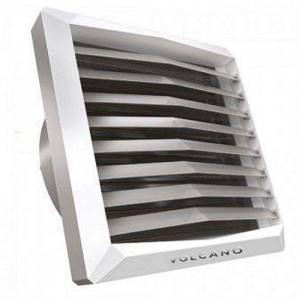
Water acts as a coolant. The maximum possible heating temperature of the working fluid for both models is 1300C with a heated air jet distance of 25 m. In the first model, namely VR1, 1.7 dm3 of water is used, and in the second - 3.1 dm3.
The maximum permissible operating pressure is considered to be 1.6 MPa.
We must not forget that the use of water under pressure as a coolant requires additional protection with a possible increase in this indicator. But the conditions are also taken into account that when temperatures drop to negative values, the heat exchanger may rupture if there is water in the system.
Features of installation and operation of equipment
Since these devices belong to the air-heating group, their power comes from a 380 V network. An electrician who has the appropriate permit to carry out technical work can be invited to connect them. The only condition before connecting is the correctly calculated power consumption, which must be taken into account to protect the wires from damage and prevent fire due to a short circuit.
Devices used in heating are connected only with steel pipes. Experts recommend using a pre-galvanized type of pipe to increase its service life, because during operation the metal may be exposed to corrosion, as well as the appearance of deposits and subsequent “overgrowth.” Pipes that are made of metal-plastic and polymers are unsuitable, because during the work they will use water heated to 1300C.

There are two installation methods:
- wall;
- vertical.
When using the wall method, it is necessary to take into account a free distance of at least 30 cm from the wall. It must be left to ensure air flow.
In workshops or warehouses where volatile, explosive or aggressive substances are stored, the use of installations using electric current is prohibited
Particular attention should also be paid when used in metalworking shops because graphite, which can be used as a lubricant, as well as fine sawdust released during operation, are capable of conducting current.
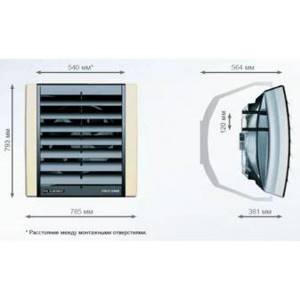
Types of air heating
There are two fundamentally different schemes for this type of heating
Air heating combined with ventilation
Heated air is transferred using elements of supply and exhaust ventilation. In this case, the operating parameter is not only the room temperature, but also the specified air exchange rate.
Heat is generated using boilers or gas heat generators. A system of air ducts is connected to them, through which warm air is distributed throughout all areas of the heated premises. The system can be supplemented with filtration, a humidifier, and a recuperator.
Air heating units
8, 366-84-44, 366-85-29
In air heating units AO2, hot water or steam at a temperature of 95-150°C is used as a coolant. The AO-2 unit heats recirculated, external or mixed air.
It can also be used as an air cooler when cold water is supplied and there is a tray for collecting condensate.
The fan of the AO2 unit is a general-purpose axial fan with a supply voltage of 380 V.
The heaters are bimetallic, spiral-knurled. KSk water heaters are used if the coolant is hot water, and if steam is used, KPSk steam heaters are used (heat exchangers are also bimetallic, spiral-roll type VNV-113 and VNP-113 with 3-4 rows of tubes in the direction of air movement. If the coolant water, then use type VNV-113, if the coolant is steam, then VNP-113).
The air passage and air distribution valve are made of 2 mm sheet steel.
The efficiency of using the supplied heat, the size and configuration of the air flow, and the degree of comfort depend on the configuration of the valve of the AO-2 unit. As standard, the valve blades have a horizontal position, which allows you to regulate the heat flow in the vertical plane. The valve blades are made of 2 - 3 mm unformed steel and are bolted to fix the position of the blade and the direction of the outgoing air flow. Each blade is individually manually adjustable.
The base of the air heating unit AO2 has 4 mounting holes that allow you to fix the unit on the installation site or in another place.
– ambient air temperature from minus 10 to + 35°С;
– relative air humidity up to 80% at a temperature of 25°C;
– environment – non-explosive, with permissible content of aggressive gases, vapors and dust in concentrations not exceeding the values established by GOST 12.1.005-88.
The air supplied by the fan is heated, passing through the heater, and supplied to the room.
AO-2 units have high thermal performance and efficiency, which are ensured by the optimal distance between the fan and the heater, eliminating stagnant zones when air moves in the unit, as well as the use of high-quality heaters and axial fans.
air heating units
Air heating unit AOD
| We offer air-heating units AOD based on heaters of the KSK type (air heating using water), heaters of the KPSK type (air heating using water steam) and heaters of the EK type (air heating using electricity). All models of such units differ in heat and air performance parameters. Air heating units AO2 are used for air heating of premises. Steam at a temperature of 95-150°C or hot water is used as coolants for air heating units. Heating of mixed, external or recirculated air is carried out by the AO2 unit. It is also used as a good air cooler if there is a condensate tray and regular cold water supply. The composition of the air heating unit: heater (heat exchanger), air distribution valve, air passage, base and fan. The fan of the AP unit is a general-purpose axial fan with a supply voltage of 380V. There are spiral-knurled and bimetallic heaters. If the coolant uses hot water, then KSk water heaters are installed, and if steam is used, then KPSk steam heaters are installed. 2 mm sheet steel is the material from which the air distribution valve and air transition are made. The configuration and dimensions of the air flow, the efficiency of the heat supplied and the degree of comfort depend on the valve configuration of the AB unit. As standard, the valve blades have a horizontal position, which makes it possible to regulate the heat flow in the vertical plane. The valve blades (unformed steel 2-3 mm) are bolted to fix the direction of the outgoing air and establish the position of the blade. Each blade can be adjusted individually by hand. | Air heating unit AOD |
Advantages
Air heating units Volcano VR1 and Volcano VR2 have a number of advantages when compared with conventional electric convectors, the main ones of which are:
- high heating rate;
- heat is distributed evenly throughout the entire space of the room;
- economic benefit from use;
- ease and speed of installation of equipment.
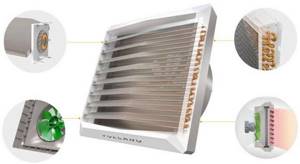
The dampers through which warm air escapes can change in any direction, which is why the space is saturated with heat. In the process of forced airflow, which is used during operation of the device, there is a forced removal of heat from the heat exchanger, and it is many times greater when compared with convection flows.
Cost-effectiveness when using these devices is achieved due to the uniform distribution of heat. For example, to heat a warehouse with a height of 10 meters, the temperature below should reach a value of 16-180C, and at the same time the air under the ceiling will be heated to at least 300C. In order not to lose the “lion’s” share of the heat released for heating the room through the roof, it is necessary to use these units.
We must not forget that thanks to the use of equipment for heating purposes, excess moisture is eliminated in the premises, which can lead to corrosion and fungus.
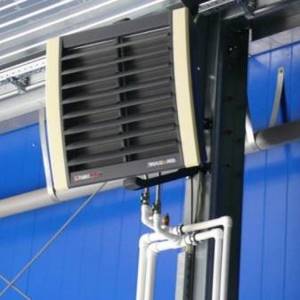
The ability to turn on the units in hot weather improved its functionality. During this period of the year, it serves as a regular fan, which provides a flow of fresh air into the room, thereby creating favorable conditions.
Compared to their predecessors, Volcano VR1 and VR2 have the ability to supply warm air over long distances, and the special design of the heat exchanger used made it possible to increase heat transfer by more than 20% than previously used models.
To give an aesthetic appearance, the developers placed all the connection connectors on the rear panel, thereby hiding them from the eyes of users.
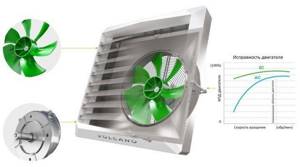
An air heating unit is a good heating option
1. Operating principle of the air heating unit
2. Electricity as a coolant in an air heating unit 3. Operation of an air heating unit on water 4. Advantages of air heating units 5. Features of installing air heating units
Considering various options for heating equipment, one cannot help but note such a mechanism as an air heating unit, which can provide worthy competition to today's popular convectors and radiators. This device differs in some installation features, so you should consider in more detail what types of air heating units are available and what technical characteristics they have.
Advantages and disadvantages
First, we need to say that such devices can serve large spaces. At the same time, such a type of model as the STD 300 was specially developed for this type of work. Such equipment is usually equipped with fairly powerful fans that can operate in several modes.
Various models of such devices have their own additional features and power, although these products can be called more typical for industrial premises
Considering that air heating units carry out directional movement of flows, the rate of heating of the room becomes the maximum among products of this type. It is thanks to these properties that these devices are actively used in industrial or public buildings, where the entrance doors are often opened or there are holes in the insulation.
All designs like VR1 and similar ones have louvered grilles, and they can redirect hot air in the desired direction. This makes it very possible to heat certain areas, arranging their own circulation of masses in the required direction.
It is also worth noting that such heaters have a fairly simple design and an elementary installation method. That is why they are easy to install with your own hands, without the help of specialists.
Graphic model of air mass distribution when using an entire system of such heaters
Among the disadvantages of these systems are high heating costs and a certain noise level. However, given the scope of application of such structures and their advantages, this is practically insignificant.
Advice! Typically, the grilles of these heaters are directed downwards, while the device itself is installed at a height.
So hot air enters the lower layers and rises from there due to temperature, warming up the entire room.
A control circuit option for connecting similar equipment using a separate thermostat
Recommendations from the experts
STD type models are considered one of the most practical. However, steam or water are most often used for heating them. Therefore, this fact should be taken into account when choosing equipment.
Some installations of this type of heating are quite compact in size and can be portable if necessary.
- It is worth combining all devices into one network and connecting them to the control panel. In this case, the heating area and the fan itself are mounted in different circuits, so that in the summer the structure can be used as ordinary fans.
- It is necessary to select the power of the products so that the system operates at optimal parameters. Otherwise, there will be high food costs, which means the price will increase.
Modern heaters of this operating principle can have a pretty good appearance that will fit into any interior
Features of carrying out competent calculations
Despite the assurances of would-be experts, it is very difficult to independently calculate air heating. Only specialists can do this task.
The customer can only check the availability of all project items, which include:
- Determination of heat losses for each heated room.
- Type of heating equipment indicating the required power, which should be calculated based on actual heat loss.
- The required amount of heated air, taking into account the power of the selected heating device.
- Required cross-section of air ducts, their length, etc.
These are the main points for calculating the heating system. It would be right to order a project from specialists. As a result, the customer will receive several calculation options from which he can choose and implement the solution he likes best.
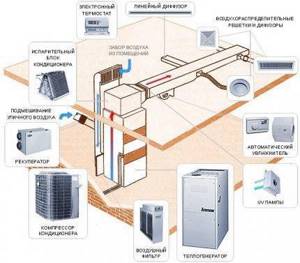
An air heating system is a complex structure consisting of many elements. To calculate it, it is better to involve professionals; to familiarize yourself with the components, it is worth studying the diagram in detail (+)
How to choose air heating units
Heat loss depends on the design, materials and thickness of these fences. The orientation of the walls to the cardinal directions, wind speed, etc. affect heat losses. However, the main factor determining heat loss is the temperature difference between indoor and outdoor air. As a reference temperature during the cold periods of the year, the calculated winter outside air temperature is selected according to the relevant standards. For Kyiv it is -22 degrees.
We should not forget that in the same room there may also be heat gain, i.e. internal heat sources. These are people, computers, copiers, lighting, as well as units, machines and devices that produce heat, which is spent on heating the air in the room. It is quite possible that the room already has heating devices or there is supply ventilation that partially heats the room. Naturally, this should be taken into account when calculating heat loss.
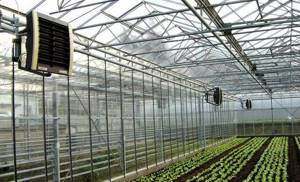
The manufacturing company of air heating units has developed an approximate method for calculating the required thermal power for heating and maintaining the desired air temperature in the room.
This method is based on the materials presented in the reference book "Heating and air conditioning" Recknagel, Sprenger, Honmann, Schramek, Gdansk 1994.
The power of heat sources required to maintain a constant level of air temperature in the room can be calculated using the formula:
Q1 = qv * Vexternal * (tinner - touter) * 0.001
Where:
Q1 - total power required to heat the room, kW
qv—specific thermal power, W/m3 K
Vexternal - external volume of the room (width x height x length), m3
tint — indoor air temperature (required), °C
tout - winter design temperature of outside air, °C - (from table)
Air heating devices are available in two sizes - with a single-row and double-row water heater, the power of which is 28 kW and 48 kW, respectively. It is clear that if one device is not able to cover the heating load, then several of them need to be installed.
n = Q/Q1
Operating principle of air heating
The heating system, where the coolant is hot air, is practical and easy to operate. The operating principle of such a system is based on thermoregulation. This method is used for both heating and air conditioning. The function of a heat generator is performed by various equipment - it can be an electric heater, boiler or furnace running on gas, solid or liquid fuel.
Regardless of what equipment is installed, the working algorithm is the same:
- The heat obtained by burning fuel is sent to the heat exchanger.
- The air mass, heated to a certain temperature (45-60 degrees), moves through air ducts (round or rectangular). The advantage of round air ducts is low aerodynamic drag. Thanks to their modern design, elements with a rectangular cross-section fit harmoniously into the interior.
- Warm air enters the room through special distributors that are installed at the outlet of each air duct.
The cooled air is returned to the heat generator for reheating through grilles installed in the floor or through return air ducts. On average, the air flow in the system varies from 1000 to 3800 cubic meters. meters per hour. Working pressure - 150 Pa.
Natural air circulation
The simplest option is to supply coolant through initial heating. The rising air enters the rooms through air ducts, after which it falls down and returns for reheating. The only drawback of natural circulation is the presence of a large amount of cold air masses that enter the room through windows and doors. In this case, the circulation process is disrupted and the entire system malfunctions. To create optimal temperature conditions and climate, the parameters of the main air duct must be more than 30 meters in length, and the branches - 15 meters.

